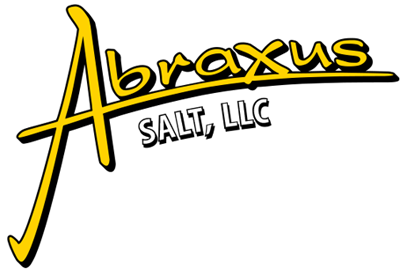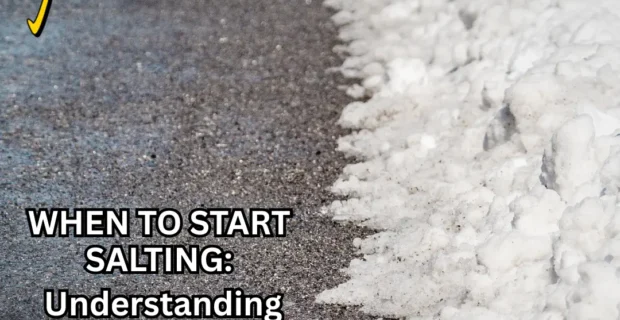When to Start Salting: Understanding Pavement Temperatures and Timing
Winter weather brings unique challenges for businesses, municipalities, and property managers responsible for keeping roads, sidewalks, and parking lots safe. One of the most important questions facing decision-makers is: when is the right time to start salting? Applying salt too early can waste resources, while applying it too late can allow ice to form, creating hazards for drivers and pedestrians. The key lies in understanding pavement temperatures and timing applications for maximum effectiveness and safety.
Why Pavement Temperature Matters
Many people assume that air temperature alone determines when ice will form. However, pavement temperature often tells a very different story. Asphalt and concrete retain heat differently than the air around them. For example, on a sunny winter day with air temperatures around 25°F, pavement exposed to sunlight can be several degrees warmer, delaying ice formation. Conversely, at night, pavement can cool rapidly and fall below freezing even when air temperatures remain above 32°F. Monitoring pavement temperature is critical because it dictates whether moisture on the surface will freeze.
The Science Behind Salt
Salt works by lowering the freezing point of water, creating a brine that prevents ice from bonding to pavement. However, salt’s effectiveness depends heavily on temperature. Regular rock salt (sodium chloride) works best when pavement temperatures are above 15°F. Below that threshold, other treatments like calcium chloride, magnesium chloride, or blended products may be necessary. Applying salt at the right time ensures it dissolves quickly, forming a brine that prevents slippery conditions before they develop.
Timing is Everything
Timing salt applications requires a balance between preparation and efficiency. Pre-treating pavement before a storm can keep snow and ice from bonding to the surface, making plowing and cleanup more effective. This proactive approach is especially useful when freezing rain or light snow is predicted. On the other hand, if salt is applied too early and precipitation is delayed, traffic can scatter the material, reducing its effectiveness and leading to waste. Decision-makers must carefully watch weather forecasts and surface conditions to strike the right balance.
Using Weather Data and Forecasts
Advances in weather forecasting technology and pavement monitoring tools give maintenance teams the ability to make science-based decisions. Sensors embedded in pavement can provide real-time surface temperatures, while road weather information systems (RWIS) deliver localized data on conditions. By combining these tools with reliable weather forecasts, managers can determine the optimal time to apply salt, maximizing both safety and cost-effectiveness.
Common Scenarios and Best Practices
1. **Clear but Cold Nights**: When air temperatures remain slightly above freezing but pavement dips below 32°F overnight, frost can form. In these cases, a light application of salt before the evening commute or early in the morning can prevent slippery patches.
2. **Before a Storm**: Pre-treating surfaces with brine or a light layer of salt can keep snow from bonding, easing mechanical removal efforts. This is especially effective for freezing rain or mixed precipitation events.
3. **During a Storm**: When snowfall is steady, intermittent salting helps prevent accumulation from compacting into ice under vehicle or foot traffic. Salt should be reapplied as needed to maintain effectiveness.
4. **After Plowing**: Once the bulk of snow is removed, applying salt helps melt residual snow and slush, leaving a safer, drier surface.
The Cost of Getting it Wrong
Applying salt at the wrong time can have significant consequences. Too early, and you waste material, labor, and money. Too late, and ice may already have formed, making conditions dangerous and requiring heavier applications to regain safety. Overuse of salt also carries environmental consequences, as chlorides can damage vegetation, corrode infrastructure, and affect waterways. This makes precise timing even more critical.
Safety and Liability
For property owners and managers, the stakes are high. Slip-and-fall accidents or vehicle crashes caused by untreated pavement can lead to costly lawsuits and reputational harm. By following a science-based approach to salting, organizations not only protect the public but also reduce liability exposure. Demonstrating that salting decisions were made using reliable data and industry best practices can provide important documentation in the event of legal claims.
Building a Decision-Making Framework
To improve salting strategies, many organizations adopt a decision-making framework that incorporates the following steps:
– Monitor pavement temperatures, not just air forecasts.
– Use reliable weather data and RWIS systems for localized information.
– Identify storm type (snow, sleet, freezing rain) and expected timing.
– Match deicing materials to forecasted pavement temperatures.
– Apply salt proactively but not prematurely.
– Reassess conditions regularly and adjust plans as needed.
The Role of Training and Communication
Even with the best tools, the human element remains critical. Crews must be trained to interpret pavement temperature data, understand material properties, and communicate effectively during winter events. Establishing clear protocols ensures consistency across teams and helps avoid costly mistakes. Communication with stakeholders—whether tenants, employees, or the public—also builds confidence that safety is being prioritized.
Looking Ahead: Smarter Salting
The future of winter maintenance is moving toward smarter, more sustainable salting practices. Technology such as GPS-equipped spreaders can control application rates with precision, reducing waste. Brine-making systems allow organizations to pre-wet salt, enhancing effectiveness and reducing scatter. Some municipalities are experimenting with alternative treatments like beet juice blends or sand-salt mixes to improve traction and reduce chloride use. These innovations, combined with careful monitoring of pavement temperatures, will shape the next generation of winter safety strategies.
Deciding when to start salting is both a science and an art. Pavement temperature, not just air temperature, should guide every decision. By applying salt at the right time—before ice bonds but not so early that it’s wasted—organizations can maximize safety, minimize costs, and protect the environment. Leveraging modern tools, training, and best practices ensures that each storm is met with a proactive, well-informed response. For Abraxus Salt customers, this means confidence in both the science and the service behind every winter event. Knowing when to salt isn’t just about weather—it’s about making the right call at the right time for safety, efficiency, and responsibility.

